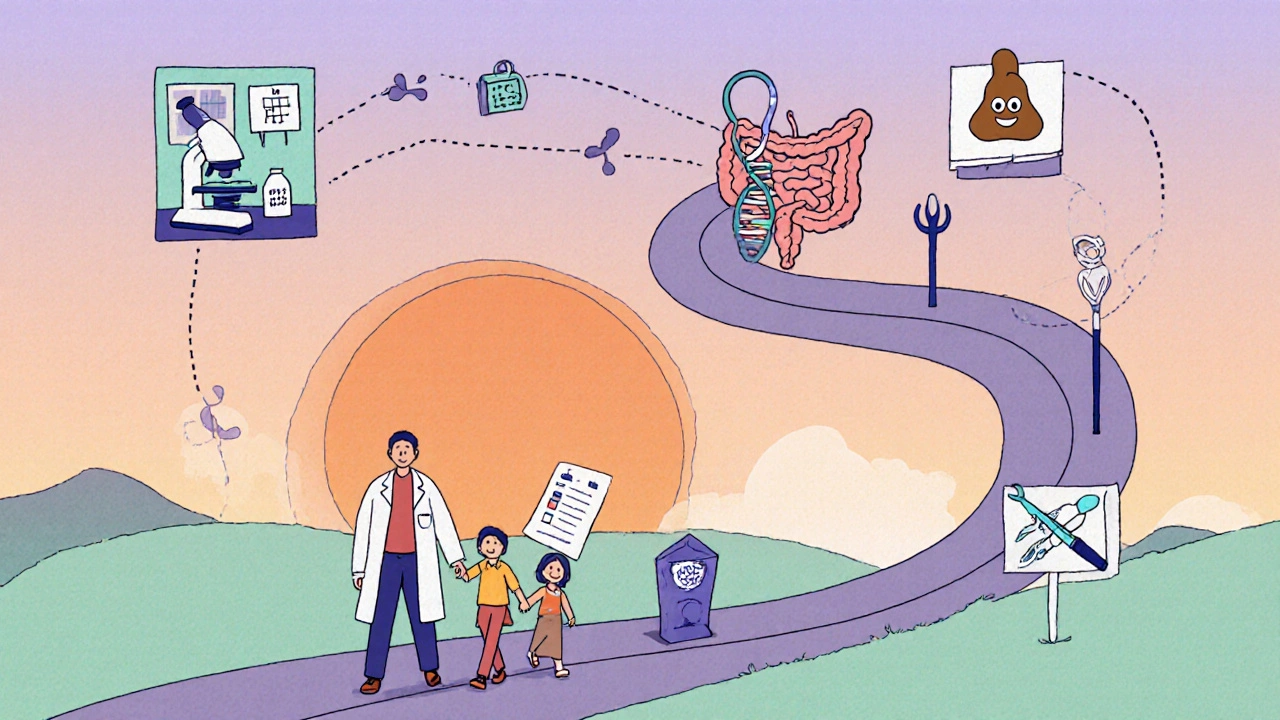Why Early Detection Is Critical for Effective Polyposis Management

Polyposis Surveillance Planning Tool
Personal Information
Why Early Detection Matters
Early detection can reduce colorectal cancer risk by more than 90%. Polyps follow a predictable pathway from normal mucosa → adenoma → carcinoma. A 2023 study showed a 92% reduction in cancer mortality when surveillance began before age 15 and continued annually.
For every 1mm increase in polyp size: 5% higher chance of malignant transformation
When polyp reaches 10mm: Risk can exceed 30%
Your Personalized Surveillance Plan
This tool provides general guidance based on current medical knowledge. Please consult with your healthcare provider for personalized medical advice.
Quick Takeaways
- Polyposis is a group of hereditary conditions that cause dozens to thousands of colon polyps.
- Detecting polyps early cuts colorectal‑cancer risk by more than 90%.
- Colonoscopy, genetic testing, and emerging biomarker panels are the three pillars of early detection.
- Regular surveillance, timely polypectomy, and, when needed, prophylactic surgery keep the disease under control.
- Personalized surveillance plans depend on genotype, polyp burden, and family history.
When you hear the word "polyposis," you might picture an obscure genetic disorder that only affects a handful of families. In reality, polyposis syndromes drive a large share of early‑onset colorectal cancers. Catching them early isn’t just a nice‑to‑have-it's the difference between a routine endoscopy and a life‑threatening emergency.
Polyposis is a hereditary condition characterized by the development of multiple adenomatous or serrated polyps throughout the gastrointestinal tract. The most common forms are Familial Adenomatous Polyposis (FAP) and MUTYH‑Associated Polyposis (MAP). Both carry a near‑certain risk of turning into colorectal cancer if polyps are not identified and removed while they’re still small.
Why Early Detection Matters
Polyps follow a predictable pathway: normal mucosa → adenoma → carcinoma. Studies from the National Cancer Institute show that for every 1 mm increase in polyp size, the chance of malignant transformation jumps by roughly 5 %. By the time a polyp reaches 10 mm, the risk can exceed 30 %.
Early detection intercepts this progression at the adenoma stage, when removal is simple and curative. A 2023 longitudinal cohort of 2,174 FAP patients demonstrated a 92 % reduction in colorectal‑cancer mortality when surveillance began before age 15 and was continued annually.
Beyond cancer prevention, early detection spares patients from extensive surgeries. When polyps are caught early, most can be removed endoscopically, avoiding the need for prophylactic colectomy, which carries lifelong nutritional and quality‑of‑life implications.
Tools for Early Detection
Three main strategies form the backbone of an early‑detection program:
- Colonoscopy is the gold‑standard visual exam that allows direct polyp removal during the same session.
- Genetic testing identifies pathogenic variants in genes such as APC, MUTYH, and others, guiding the timing and frequency of surveillance.
- Biomarker panels (e.g., stool DNA, blood‑based methylation tests) are emerging non‑invasive options that can flag high‑risk individuals between colonoscopies.
Colonoscopy
High‑definition colonoscopy detects >95 % of polyps larger than 5 mm. For polyposis patients, the recommended interval is every 1-2 years, depending on polyp burden and completeness of prior removals. The procedure’s main drawbacks are its invasiveness, need for bowel prep, and small perforation risk (≈0.1 %).
Genetic Testing
Testing for APC mutations confirms FAP, while biallelic MUTYH variants confirm MAP. Knowing the genotype lets clinicians set age‑specific start points: FAP screening usually begins at age 10-12 years, whereas MAP may start a few years later. Testing also helps cascade screening for relatives.
Biomarker Panels
Stool DNA tests (e.g., Cologuard) and blood‑based methylation assays have sensitivities around 70‑80 % for advanced adenomas. While not definitive for polyposis, they provide a convenient check between colonoscopies, especially for patients who miss appointments.
Comparing Early‑Detection Methods
| Method | Sensitivity for ≥5 mm polyps | Invasiveness | Typical Interval | Cost (US$) |
|---|---|---|---|---|
| Colonoscopy | 95 % | High (requires sedation) | 1-2 years | 1,500‑2,000 |
| Genetic testing (APC/MUTYH) | 100 % (identifies risk, not polyps) | Low (blood draw) | Once; informs future intervals | 400‑800 |
| Stool DNA (e.g., Cologuard) | 78 % | Low (home kit) | 3 years | 600‑700 |
Managing Detected Polyps
Once a polyp is found, the management pathway depends on size, histology, and patient genotype.
- Endoscopic polypectomy: Preferred for polyps up to 2 cm. Techniques include cold snare, hot snare, and endoscopic mucosal resection.
- Surveillance escalation: After removing >5 polyps or any with high‑grade dysplasia, shorten the interval to 6‑12 months.
- Prophylactic colectomy: Recommended for FAP patients with >100 polyps or when polyps become unmanageable endoscopically. Options include total proctocolectomy with ileal‑pouch‑anal anastomosis or subtotal colectomy.
Multidisciplinary care-gastroenterology, genetics, colorectal surgery, nutrition-ensures decisions balance cancer risk with quality of life.

Creating a Personal Surveillance Plan
- Confirm the genetic diagnosis (APC, MUTYH, or other). If unknown, recommend a comprehensive panel.
- Establish baseline colonoscopy: document total polyp count, size distribution, and pathology.
- Set interval based on guidelines:
- FAP: colonoscopy every 1 year starting age 10‑12.
- MAP: colonoscopy every 1‑2 years starting age 30‑35.
- Other polyposis syndromes: tailor according to phenotype.
- Incorporate adjunct tests (stool DNA, blood biomarkers) for interim monitoring.
- Schedule annual genetic counseling for family cascade testing.
- Document all procedures in a shared electronic health record to avoid missed appointments.
Following this roadmap turns a daunting genetic condition into a manageable health plan.
Common Pitfalls & Tips
- Skipping early colonoscopies: Delaying the first exam past age 15 in FAP can allow polyps to exceed 5 mm, dramatically raising cancer risk.
- Ignoring family‑history updates: New diagnoses in relatives may change risk stratification.
- Neglecting bowel prep quality: Inadequate prep misses up to 15 % of small polyps.
- Assuming a clear colonoscopy means no risk: Genetic risk persists; continue surveillance even after a clean sweep.
- Under‑communicating with your care team: Keep a printed polyp log; it helps surgeons decide if colectomy is needed.
Frequently Asked Questions
What age should I start screening if I have a family history of FAP?
Screening typically begins at age 10‑12 with a high‑resolution colonoscopy, because polyps can appear in early childhood.
Can a negative colonoscopy guarantee I won’t develop cancer?
No. A clean colonoscopy only shows the current state. Genetic risk remains, so regular follow‑up is essential.
Is prophylactic surgery ever avoidable?
If polyps stay small enough for endoscopic removal and surveillance is strict, many patients avoid surgery. However, once the burden exceeds 100 polyps, surgery is the safest route.
How reliable are stool DNA tests for polyposis patients?
Stool DNA tests have moderate sensitivity (70‑80 %) for larger adenomas but miss many small polyps. They’re useful as interim checks, not as a replacement for colonoscopy.
What lifestyle changes can support my surveillance plan?
A high‑fiber diet, regular exercise, limiting red meat, and avoiding tobacco help reduce overall colorectal‑cancer risk. These measures complement, but don’t replace, medical surveillance.
In short, the sooner you spot polyps, the easier they are to manage. early detection in polyposis isn’t a luxury-it’s the cornerstone of keeping colorectal cancer at bay and preserving a normal life.
Early detection isn’t just a buzzword-it’s the difference between a simple polypectomy and a life‑threatening emergency. By starting colonoscopic surveillance before the teen years, patients with FAP can keep their colon clear and avoid major surgery. The data show a >90 % reduction in colorectal‑cancer mortality when polyps are removed at the adenoma stage. Keep the schedule tight, stay on top of prep, and you’ll protect your future health.
Data from the National Cancer Institute consistently demonstrate a linear increase in malignant risk with each millimetre of polyp growth. A well‑executed bowel prep can uncover up to 15 % more diminutive lesions that would otherwise be missed. Maintaining a regular colonoscopy interval, especially in genetically predisposed families, aligns perfectly with evidence‑based guidelines.
The natural history of hereditary polyposis syndromes follows a well‑characterized adenoma‑carcinoma sequence that can be mathematically modelled using a multistage progression framework. In Familial Adenomatous Polyposis, the APC germline mutation initiates a clonal expansion of dysplastic epithelium, which, if left unchecked, accrues secondary hits such as KRAS or TP53 alterations, culminating in invasive carcinoma. Epidemiological cohorts have quantified that each incremental increase of 1 mm in polyp diameter corresponds to an approximately 5 % elevation in the probability of high‑grade dysplasia, a relationship that holds across both serrated and conventional adenomatous pathways. Moreover, longitudinal surveillance data reveal that initiating colonoscopic examinations at ages 10–12 yields a cumulative cancer‑free survival exceeding 98 % at two decades of follow‑up. The mechanistic rationale for this benefit is twofold: early‑stage adenomas are amenable to endoscopic resection with negligible morbidity, and the removal of the bulk of the polyp burden reduces the substrate for further mutational events. Genetic testing serves as a stratification tool, allowing clinicians to calibrate surveillance intervals according to genotype penetrance and phenotypic expression. For instance, biallelic MUTYH mutations generally manifest later, permitting a modestly extended interval of 2–3 years, whereas APC‑associated disease mandates annual examinations. Biomarker panels, such as stool‑based DNA methylation assays, augment the detection armamentarium by identifying occult lesions that may evade endoscopic visualization due to suboptimal preparation. While these non‑invasive modalities exhibit sensitivities in the 70–80 % range for advanced adenomas, they are best employed as adjuncts rather than replacements for colonoscopy. A multidisciplinary approach, integrating gastroenterology, medical genetics, and colorectal surgery, ensures that therapeutic decisions consider both oncologic risk and quality‑of‑life outcomes. Prophylactic colectomy remains indicated when polyp load surpasses the threshold for safe endoscopic management-commonly defined as >100 polyps or the presence of high‑grade dysplasia unresponsive to removal. Nutritional counselling and psychosocial support are essential adjuncts, given the profound lifestyle implications of lifelong surveillance. Finally, systematic documentation within a shared electronic health record mitigates the risk of missed appointments and facilitates cascade screening among at‑risk relatives. Continuous research into novel methylation signatures promises to further refine risk stratification. In summary, the confluence of timely genetic diagnosis, rigorous endoscopic surveillance, and emerging biomarker surveillance constitutes the cornerstone of effective polyposis management, translating molecular insight into tangible reductions in colorectal‑cancer incidence.
I agree that surveillance intervals must be individualized based on genotype and polyp burden.
That makes total sense-thanks for clarifying! 👍
Think of the colon like a garden: you’ve got to pull the weeds before they take over the whole plot. A colorful stool‑DNA kit can spot the sneaky seedlings that hide between the rows, giving you a heads‑up before the next big garden‑day. Pair that with a high‑definition colonoscopy every 1–2 years, and you’re basically a master gardener of your own gut. And hey, don’t forget the power of fiber, exercise, and a splash of optimism-those are the sunshine and water that keep the plot healthy.
They don’t want us to know that colonoscopies are just a money‑making scheme pushed by big pharma; the real cure is simple diet changes, not pricey sedatives.
Evidence‑based guidelines, not fringe theories, drive the recommendation for regular colonoscopic surveillance-numerous randomized trials have validated the >90 % mortality reduction when adenomas are removed early. The purported “diet‑only” cure lacks peer‑reviewed data and ignores the multistep mutational cascade intrinsic to polyposis. Relying solely on lifestyle without endoscopic confirmation puts patients at unnecessary risk.
Stay hopeful, we’ve got the tools to keep colon cancer at bay! 😊
In practice, the best strategy blends genetics, endoscopy, and adjunct biomarkers into a personalized surveillance roadmap. Start genetic testing early, schedule colonoscopies according to the specific syndrome, and use stool‑DNA tests as interim checkpoints. Keep a detailed polyp log, involve your family in cascade screening, and never skip bowel prep quality. With this disciplined approach, most patients can avoid prophylactic surgery and maintain a good quality of life.